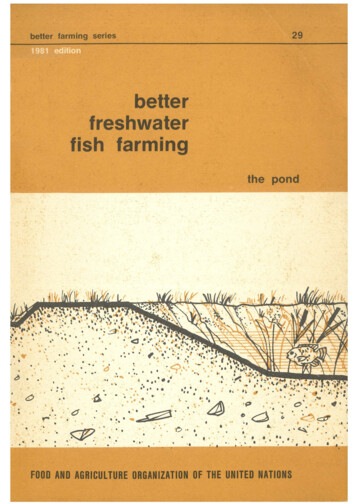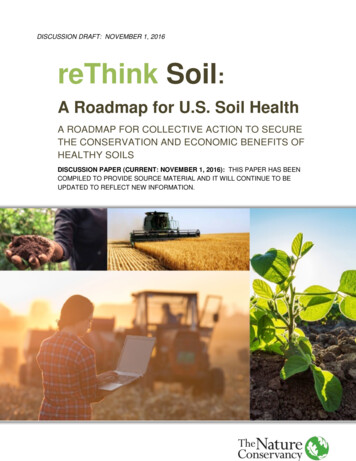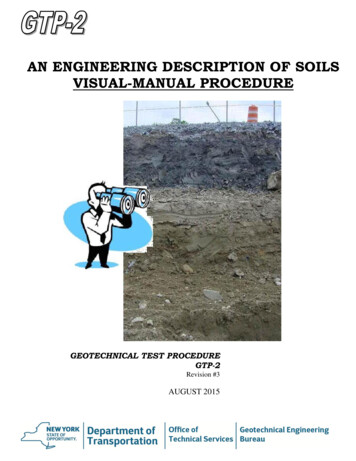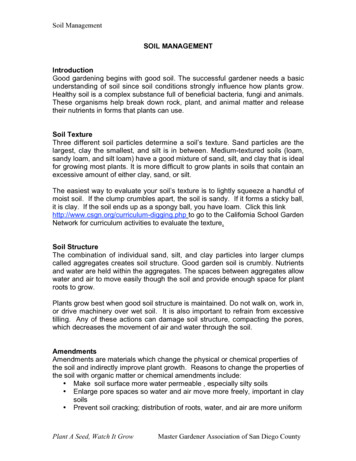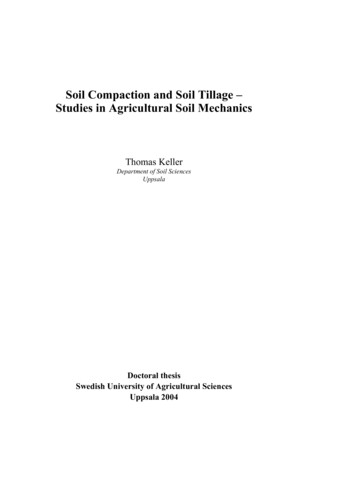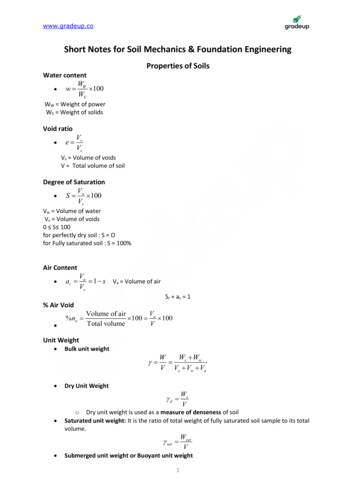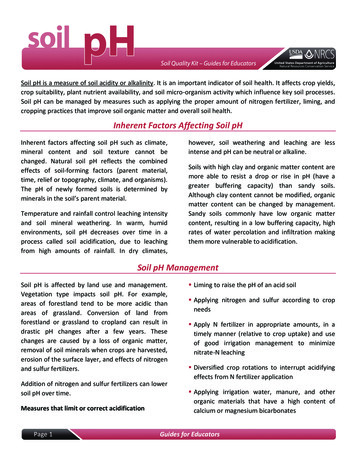
Transcription
Soil pH is a measure of soil acidity or alkalinity. It is an important indicator of soil health. It affects crop yields,crop suitability, plant nutrient availability, and soil micro-organism activity which influence key soil processes.Soil pH can be managed by measures such as applying the proper amount of nitrogen fertilizer, liming, andcropping practices that improve soil organic matter and overall soil health.Inherent Factors Affecting Soil pHInherent factors affecting soil pH such as climate,mineral content and soil texture cannot bechanged. Natural soil pH reflects the combinedeffects of soil-forming factors (parent material,time, relief or topography, climate, and organisms).The pH of newly formed soils is determined byminerals in the soil’s parent material.Temperature and rainfall control leaching intensityand soil mineral weathering. In warm, humidenvironments, soil pH decreases over time in aprocess called soil acidification, due to leachingfrom high amounts of rainfall. In dry climates,however, soil weathering and leaching are lessintense and pH can be neutral or alkaline.Soils with high clay and organic matter content aremore able to resist a drop or rise in pH (have agreater buffering capacity) than sandy soils.Although clay content cannot be modified, organicmatter content can be changed by management.Sandy soils commonly have low organic mattercontent, resulting in a low buffering capacity, highrates of water percolation and infiltration makingthem more vulnerable to acidification.Soil pH ManagementSoil pH is affected by land use and management.Vegetation type impacts soil pH. For example,areas of forestland tend to be more acidic thanareas of grassland. Conversion of land fromforestland or grassland to cropland can result indrastic pH changes after a few years. Thesechanges are caused by a loss of organic matter,removal of soil minerals when crops are harvested,erosion of the surface layer, and effects of nitrogenand sulfur fertilizers.Addition of nitrogen and sulfur fertilizers can lowersoil pH over time.Measures that limit or correct acidificationPage 1 Liming to raise the pH of an acid soil Applying nitrogen and sulfur according to cropneeds Apply N fertilizer in appropriate amounts, in atimely manner (relative to crop uptake) and useof good irrigation management to minimizenitrate-N leaching Diversified crop rotations to interrupt acidifyingeffects from N fertilizer application Applying irrigation water, manure, and otherorganic materials that have a high content ofcalcium or magnesium bicarbonatesGuides for Educators
Soil pH – Soil Quality Kit Use of continuous no-till, cover crops,applications of solid manure, and diverserotations with high-residue crops in order toUSDA-NRCSincrease organic matter content and improve soilbuffering capacity to limit changes in pH.Table 1. Crop yields relative to pH.CropSoil pH4.755.76.87.5Relative Yield (100 is the best, 0 is the 0100Timothy (grass)31476610095Methods for Assessing Soil Quality, page 173 (SSSA, 1996)Problems Related to pH and Relationship of pH to Soil FunctionSoil pH is an excellent indicator of a soil’s suitabilityfor plant growth. For most crops, a range of 6 to7.5 is best as shown in Table 1.3. Reducing contact between soil and phosphorussource (manure and/or fertilizer) by banding orinjectingSoil pH levels that are too high or too low(Figure 1.) lead to deficiency of many nutrients,decline in microbial activity, decrease in crop yield,and deterioration of soil health. For example, soilpH values below 5.5 and between 7.5 and 8.5 limitavailability of phosphate to plants (Figures 2 and 3).Four major management strategies to increaseavailability of phosphate to plants are:4. Locating P-fertilizers near crop row where rootsare most active1. Liming acid soils to increase soil pH to between6.5 and 7.0Nitrogen cycling is inhibited by low pH. Theeffectiveness and degradation of herbicides andinsecticides and solubility of heavy metals dependon pH. Some diseases thrive when soil is alkaline oracidic. Effectiveness and potential carryover ofcertain soil-applied herbicides is also impacted bysoil pH.2. Applying phosphorus fertilizer frequently insmall amounts rather than one time in a largeamountPage 2Guides for Educators
Soil pH – Soil Quality KitUSDA-NRCSFigure 2. Phosphorus availability relative to pHranges (California Fertilizer Association, 1995).Figure 1. Relationship between plant nutrientavailability and soil reaction (National Soil SurveyManual, NRCS).Figure 3. Image of corn with aphosphorus deficiency (R.L. Croissant,Bugwood.org).What current practices do you think affect soil pH?What impact do you expect these practices to have on soil pH and why?Page 3Guides for Educators
Soil pH – Soil Quality KitUSDA-NRCSMeasuring Soil pHMaterials Needed to Measure pHProbe and plastic bucket for gathering andmixing soil samples3. Place a scoop of mixed soil in your palm, andsaturate soil with “clean” water (distilled wateror rainwater).4. Squeeze soil gently until a water slurry runs outof the cup of the hand and onto the side.Roll of pH test strips1/8-cup (29.5-mL) measuring scoop5. Touch the end of a 1-inch-long piece of pH teststrip directly to slurry so that the tip is barelywet and solution can be drawn up the strip atleast 1/4" to 1/2" beyond the area masked bysoil (Figure 4).Calibrated 120-mL shaking vial with lidSquirt bottleDistilled water or rainwaterPen, field notebook, sharpie, and zip-lockbagsConsiderations – Electical conductivity shouldalways be measured before pH when using thesame sample. Soil phosphate, nitrate, and nitritelevels can be measured using the following steps.6. Compare the color approximately 1/3 of theway up the colored portion of the strip to colorchart on dispenser (Figure 5). Record soil pHand interpretations (Table 2).In-Field Quick Hand Test1. Soil Sampling: Soil pH level is highly variable,depending on field location and time of year. Itis affected by fertilizer placement in rows orbetween rows, soil texture, organic mattercontent, and applications of manure orfertilizer. Using a soil probe gather at least 10small samples randomly from an area thatrepresents soil type and management historyto a depth of 8 inches and place in a smallplastic bucket. Do not include large stones andresidue in sample. Repeat this step for eachsampling area.2. Neutralize hands by rubbing wet soil acrosspalms (discard the soil).Page 4Figure 4. Quick hand test.Compare color 1/3of the way up.Figure 5. Soil pH color chart.Guides for Educators
Soil pH – Soil Quality Kit1:1 Soil-Water Soil pH Test in Classroom1. Soil Sampling: Same as step 1 described for thein-field quick hand test.2. Tamp down one sampling scoop (29.5 mL) ofmixed soil by striking scoop carefully on a hard,level surface. Place sample in plastic mixing vial.Add one scoop (29.5 mL) of water to the samevial. The vial will contain a 1:1 ratio of soil towater, on a volume basis.USDA-NRCS(Figure 6) until the liquid is drawn up at least1/4 to 1/2 inch beyond area covered by soil(Figure 4).5. Compare color approximately 1/3 of the way upcolored portion of the strip to color chart ondispenser (Figure 5). Record soil pH andinterpretations (Table 2).3. Tightly cap vial and shake 25 times. Let thesample settle for 1 minute. Remove cap anddecant 1/16 inch of soil-water solution carefullyinto lid. Let sample sit in the lid for 2 to 3minutes.4. Take the end of a 1-inch-long piece of pH paperand immerse it 1/16 inch into solutionFigure 6. 1:1 soil water test.InterpretationsRecord soil pH and complete Table 2 by comparingmeasured soil pH to that given in Figure 1, Figure 2,and Table 1 and by answering discussion questions.In general, pH values between 6 and 7.5 areoptimum for crop and forage production andnutrient uptake. Soil pH impacts nutrientavailability and overall soil health. Soil acidificationcan also be an indication of excessive nitrogenfertilizer application.Table 2. Soil pH and interpretations.SiteEx 1SoilpH5.8Page 5Soil pH Category(from Figure 1,such as very acid)Medium AcidNutrients Impacted Crops Impactedby Soil pH (fromby Soil pH LevelFigures 1 and 2)(from Table 1)P, K, Ca, MoAll but oatsGuides for EducatorsNotesSpring test on corn stubble
Soil pH – Soil Quality KitUSDA-NRCSCompare test results recorded in Table 2 to values in Figure 1, Figure 2, and Table 1. Are soil pH levels idealfor crops or forages grown? Why or why not?Based on results of soil pH test, do you recommend liming or other measures to adjust pH? Why or why not?GlossaryAcidity – Soil pH is less than 7.Nitrification – Oxidation of ammonium-nitrogencompounds in organic material or fertilizer intonitrites and nitrates by soil bacteria, makingnitrogen available to plants.Alkalinity – Soil pH is greater than 7.Anion – A negatively charged ion.Buffering Capacity – A soil’s ability to resist changein pH. Soils with high contents of clay and organicmatter have a greater buffering capacity.Cation – A positively charged ion.Phosphorus Fixation – Phosphorus is tied up bycalcium, iron, or aluminum compounds, making itunavailable for plant uptake. Fixation is impactedby soil pH.Soil pH – A measure of soil acidity or alkalinity.USDA is an equal opportunity provider and employer.Page 6Guides for Educators
Page 1 Guides for Educators Soil pH is a measure of soil acidity or alkalinity. It is an important indicator of soil health. It affects crop yields, crop suitability, plant nutrient availability, and soil micro-organism activity which influence key soil processes.



